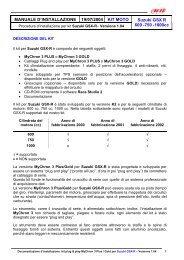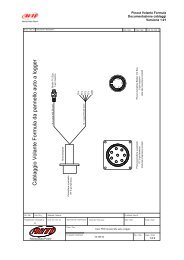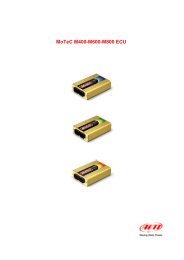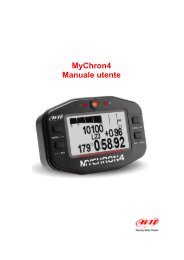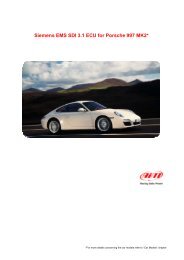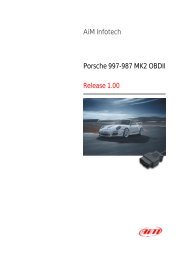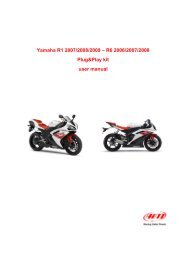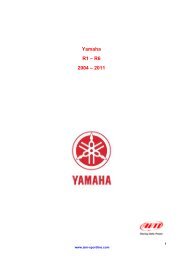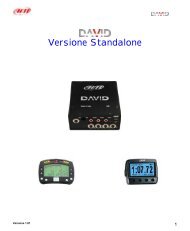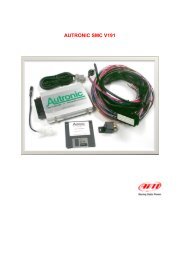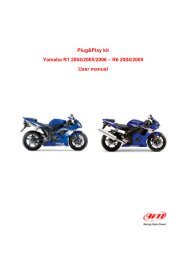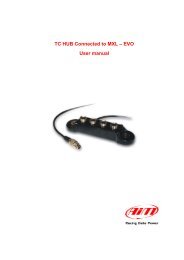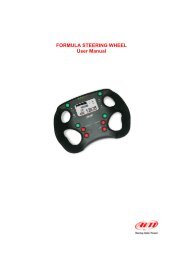Writing Math Channels in Race Studio Analysis - AIM Racing Data ...
Writing Math Channels in Race Studio Analysis - AIM Racing Data ...
Writing Math Channels in Race Studio Analysis - AIM Racing Data ...
You also want an ePaper? Increase the reach of your titles
YUMPU automatically turns print PDFs into web optimized ePapers that Google loves.
<strong>Writ<strong>in</strong>g</strong> <strong>Math</strong> <strong>Channels</strong> <strong>in</strong> <strong>Race</strong> <strong>Studio</strong> <strong>Analysis</strong><br />
Table 4. Default <strong>AIM</strong> <strong>Channels</strong> Chart<br />
Release 1.00<br />
Default <strong>AIM</strong> Channel Formula Description<br />
<strong>AIM</strong>_Max_Speed max(Speed #1,Speed #2) Calculates the maximum of the<br />
two wheel speeds at any po<strong>in</strong>t<br />
<strong>AIM</strong>_L<strong>in</strong>ear_Acc_1 deriv(Speed #1 * KMH2MS) / 9.806 Longitud<strong>in</strong>al acceleration<br />
calculation <strong>in</strong> Metric units (m/s2)<br />
by tak<strong>in</strong>g the derivative of speed<br />
Aim_L<strong>in</strong>ear_Acc_2 deriv(Speed #1 * MI2KM * KMH2MS) /<br />
9.806<br />
Longitud<strong>in</strong>al acceleration<br />
calculation <strong>in</strong> English units<br />
(ft/sec2) by tak<strong>in</strong>g the derivative<br />
of speed<br />
<strong>AIM</strong>_Slip_Factor slip(Eng<strong>in</strong>e, Speed #1) Clutch slip as a function of<br />
eng<strong>in</strong>e RPM and wheel speed<br />
<strong>AIM</strong>_G_sum sqrt((AccLat^2)+(AccLong^2)) Sum of the acceleration forces to<br />
calculate total acceleration<br />
<strong>AIM</strong>_Gear gear(Eng<strong>in</strong>e, Speed #1, 1, 6) Gear calculation as a function of<br />
eng<strong>in</strong>e RPM and speed<br />
<strong>AIM</strong>_Aeropower (0.5 * 1.23 * FRONTSURF * Cx * (Speed<br />
#1 * KMH2MS)^3)/1000<br />
<strong>AIM</strong>_Wheelpower <strong>AIM</strong>_Aeropower + (MASS * (Speed #1 *<br />
KMH2MS) * (L<strong>in</strong>ear Acc. * ACCGRAV)) /<br />
1000<br />
<strong>AIM</strong>_Kus ACCGRAV*(((Steer*DEG2RAD)/(Lateral<br />
acc.*ACCGRAV))-<br />
(WHEELBASE/((Speed<br />
#1*KMH2MS)^2)))<br />
Power required to overcome drag<br />
as a function of Frontal surface<br />
area, drag coefficient, and speed<br />
Power required to accelerate the<br />
vehicle at a certa<strong>in</strong> acceleration<br />
as a function of drag, vehicle<br />
mass, speed and longitud<strong>in</strong>al<br />
acceleration<br />
Understeer/Oversteer calculation<br />
us<strong>in</strong>g the relationship between<br />
steer<strong>in</strong>g angle and lateral<br />
acceleration, and wheelbase and<br />
speed<br />
<strong>AIM</strong>_DistanceMeters lap_<strong>in</strong>teg(Speed #1 * KMH2MS) Distance of a lap <strong>in</strong> meters<br />
calculated by f<strong>in</strong>d<strong>in</strong>g the <strong>in</strong>tegral<br />
of speed over lap time<br />
<strong>AIM</strong>_DistanceFeet lap_<strong>in</strong>teg(Speed #1 * MPH2FTS) Distance of a lap <strong>in</strong> feet<br />
calculated by f<strong>in</strong>d<strong>in</strong>g the <strong>in</strong>tegral<br />
of speed over lap time<br />
<strong>AIM</strong>_Time time() Time<br />
The first step to creat<strong>in</strong>g a math channel is to determ<strong>in</strong>e which test you wish to create this math channel<br />
for. Any test you currently have open will show up as a bullet across the top of the screen for you to<br />
choose from, as shown <strong>in</strong> the screenshot above <strong>in</strong> Figure 1. Now there are two ways to create the<br />
channel. You can either use one of the “General” formulas that are already <strong>in</strong> the software, or you can<br />
create one from scratch. Later we will show how to create one from scratch, but let us review how to use<br />
the already exist<strong>in</strong>g formulas to meet your needs.<br />
www.aim-sportl<strong>in</strong>e.com 5




